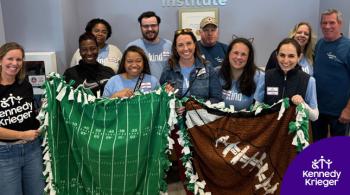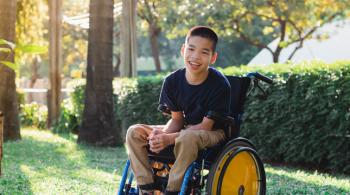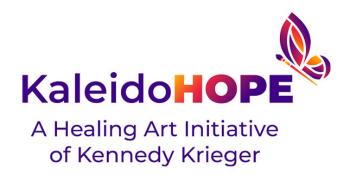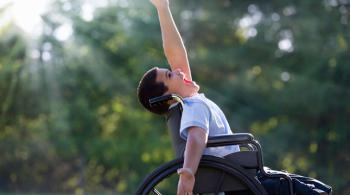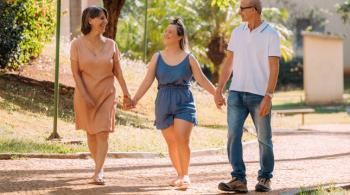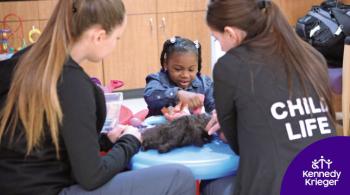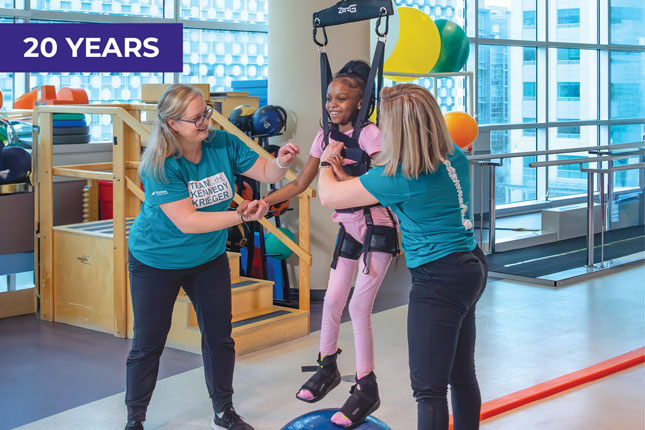
By Marc Shapiro
In 2006, Ben Trockman was just 17 years old when an off-road motorcycle accident in Kentucky completely altered the trajectory of his life. The injury to his C1 and C2 vertebrae, similar to the injury actor Christopher Reeve experienced, led to severe spinal cord injury and paraplegia.
About five months into his recovery, Trockman came to Kennedy Krieger Institute’s International Center for Spinal Cord Injury (ICSCI), which celebrates its 20th anniversary this year. As one of the top spinal cord injury centers in the world, the ICSCI incorporates the latest research and technology into clinical care to help children and adults with acute and chronic spinal cord injuries and spinal cord disease-related paralysis improve their overall health and recover day-to-day and neurologic functioning.
“An injured nervous system is not static, and you need to support and optimize the functioning of the remaining nervous system,” says Dr. Cristina Sadowsky, a co-founder of the center and the clinical director since its founding. “You need to reproduce the same kind of movement that you have during normal living and normal activity to optimize restoration and recovery.”
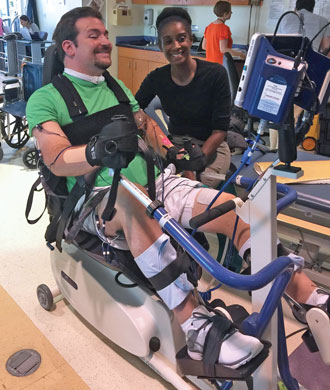
Trockman, who has no functional movement below his shoulders, uses a power wheelchair to get around and has a pacing device that electrically stimulates his diaphragm to help him breathe. At the ICSCI, staff members helped Trockman use assistive devices to stand and move his arms and legs, applied electrostimulation to stretch and strengthen his muscles, and taught him about skin care for people who use wheelchairs.
Now 36, Trockman works full-time and was recently elected president of the city council of Evansville, Ind.
“The therapists, the directors, the healthcare professionals at Kennedy Krieger became my best friends, my confidants and my support system,” Trockman says. “I would not be where I am today without the people at Kennedy Krieger.”
An International Leader
Stories like Trockman’s motivate the center’s staff, which consists of four physicians and 70 physical and occupational therapists, all of whom specialize in spinal cord injury. The center opened in June 2005 with 10 employees, serving over 150 patients that year. By 2024, those numbers had grown to 129 employees and over 900 patients.
It’s the enthusiasm, it’s the atmosphere, it’s ‘Hope Through Motion.’” – Janet Dean
Over the past two decades, the center has developed a unique combination of interdisciplinary programs treating patients from every angle, including bone health, mental health, bowel and bladder management, aquatic therapy, adaptive sports and more. In 2019, the center opened a second location, in Howard County, Md., and in 2023, a third location, in Baltimore County. Dr. Sadowsky estimates that it’s likely the largest program of its kind in the country.
The center uses activity-based restorative therapies to help patients relearn how to move. It has 10 cutting-edge pieces of equipment that allow for partial weight-supported walking, including the world’s first ZeroG 3D®, a groundbreaking gait trainer that allows individuals with spinal cord injuries full freedom of movement. Dozens of other technologies are also available to help patients regain motion.
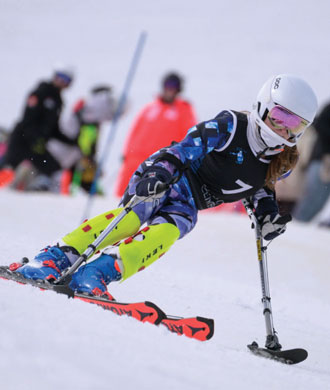
‘They’ve Done Everything for Us’
At just 8 months old, Victoria got really sick—at one point she stopped moving. Her parents would soon learn that she had transverse myelitis, a rare neurological condition in which the spinal cord is inflamed, causing pain, muscle weakness and other physical issues. They needed to get Victoria to an inpatient rehabilitation facility, and doctors said Kennedy Krieger’s ICSCI was the best.
“ICSCI clinicians really held our hands and guided us through the whole process,” says her mom, Mandy. “At one point, we were praying she’d get motion in one hand back so she could work an electric wheelchair. Now, she’s ambulating with [forearm] crutches and just went to prom.”
Victoria, 17, is also a downhill alpine skier, ranked No. 5 in the country for giant slalom. (Nos. 1, 2 and 3 are on the U.S. Paralympic ski team.) She has been skiing since she was 4.
“Para-skiing has really helped me in growing strength and feeling a bit normal in my condition,” she says. “It helps me stay active and play a sport that I love. Also, I’m around people who are like me.”
After her initial three-month inpatient stay at Kennedy Krieger, Victoria spent eight weeks a year for several years at the ICSCI in quarterly, two-week sessions. Mandy says the ICSCI taught them all about how to care for Victoria, including what braces to use and what exercises to do back home in New York.
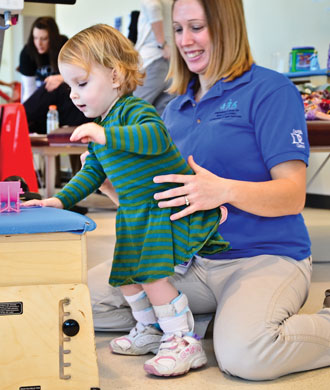
“They’ve really just done everything for us,” Mandy says. “We credit so much of her progress to them.”
Janet Dean, the ICSCI’s recently retired pediatric nurse practitioner, who joined the staff in the center’s second year, says working with families like Victoria’s is one of the things she loved most about the job.
“We were able to build the program so kids can come from all over the country—and the world—and see a team that works 100% with pediatric spinal cord injuries,” she says. “There’s been many times when people have come to our program and said they’ve learned more or done more in the first week here than they’ve done since their injury.”
Victoria recalls practicing walking as a child in the ICSCI’s gym—her therapists would hide princess dolls in different places, and she’d go on a scavenger hunt to find them. Dean says this is just another little touch that distinguishes the center.
“I don’t know how many times I’d go into the gym and see little stuffed frogs all over that kids are walking to find,” she says. “It’s the enthusiasm, it’s the atmosphere, it’s ‘Hope Through Motion’”—the center’s motto. “When you come here, people are enthusiastic, they’re hopeful and they’re joyful.”
Did you know? ICSCI has served 3,700+ patients since 2005.
Photo captions: Photo one: Physical therapists Meredith Linden and Erin Michael assist Se’majea in using a ZeroG body weight-supporting device; Photo two: Ben Trockman at Kennedy Krieger; Photo three: Victoria is a nationally ranked downhill alpine skier; Photo four: Victoria at Kennedy Krieger



